Foods of Fukuoka: Delicious seasonal seafood found in and around the Fukuoka area – June Edition
Here in Fukuoka, thanks to the city’s coastal location you can get from the city center to the sea in no time at all.
So today FFJ writer “Doggy Man” is going to show us some of the delicious seafood you can catch and enjoy in and around Fukuoka each season.
Contents
Fukuoka Seafood
Here in Fukuoka, thanks to the city’s coastal location you can get from the city center to the sea in no time at all. So today FFJ writer “Doggy Man” is going to show us some of the delicious seafood you can catch and enjoy in and around Fukuoka each season.
Japan has a long culinary tradition of eating raw fish (sashimi), but there are a number of other ways to prepare seafood in traditional Japanese cooking, such as grilling, simmering and deep-frying, to name just a few.
Sushi has become increasingly popular worldwide over recent years, a trend which has led to an increased number of tourists coming to Japan from overseas specifically seeking to discover authentic Japanese sushi for themselves.
And the streets of Fukuoka are no exception. It has become commonplace to spot foreign tourists enjoying local sashimi or sushi dishes throughout the city, some with impressively good chopstick skills and others not so much, but either way it is an image which brings a smile to the locals’ faces here in Fukuoka.
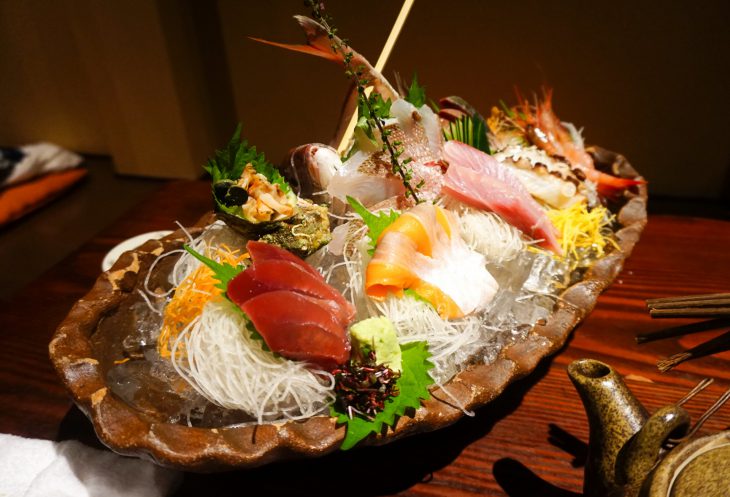
The sea located to the north of Kyushu is known for its plentiful seafood, thanks to its geographic location with respect to the ocean. Found right on this veritable sea of plenty, Fukuoka itself is blessed with a plethora of delicious varieties of fish, shellfish, edible seaweed and other kinds of seafood.

In addition to famous local specialties such as ramen, motsunabe, and mentaiko, Fukuoka is also known for its delicious seafood, and indeed the city of Fukuoka is home to the largest number of seafood restaurants per capita in all of Japan! The Nagahama Fish Market, also located near the city center, is likewise lined with a variety of the freshest local catches of the day.
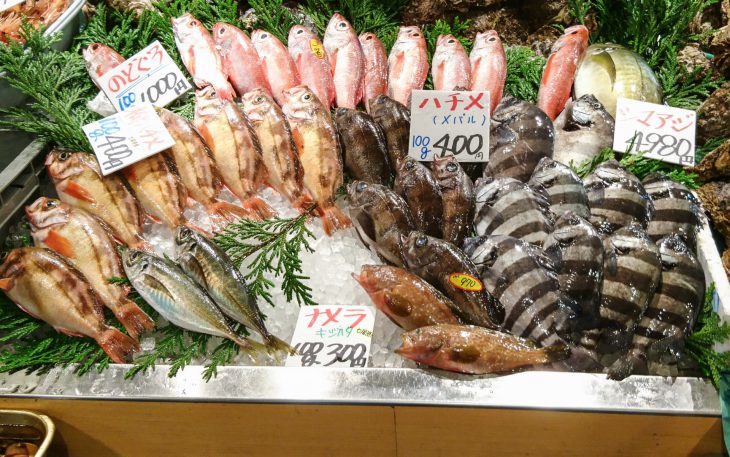
Given the overall high quality of Fukuoka’s restaurants, it is only natural that the locals would have great taste in food!
And this in turn raises the bar for both top-tier traditional Japanese chefs and everyday cooks alike, as well as the fishermen who work hard to prepare and provide the very best, freshest product, filling the fish market with a wide variety of fish from all over Kyushu, which then makes its way to the restaurants where the delicious final product makes for happy, satisfied locals, thus completing the cycle of delicious seafood.
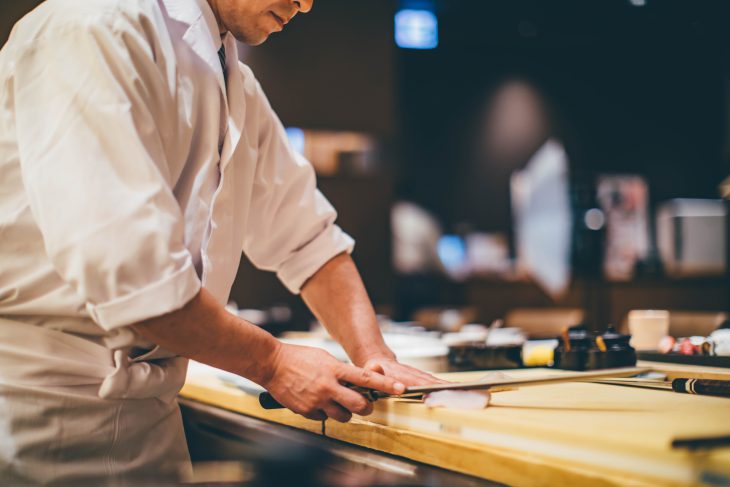
Tourists from all over Japan and the world all rave about Fukuoka’s great food, so much in fact that it would not be an overstatement to say that there are no bad seafood restaurants in the city!
Each type of seafood comes into season at a specific time of year which is when it is at its freshest and best tasting. So we would like to give you the rundown of what’s in season each month, so you can enjoy the best fresh catch of local Fukuoka fish any time of the year!
Chub Mackerel ・Saltwater Eel ・Horse Mackerel・Japanese Whiting
【June Edition】
「Chub Mackerel」
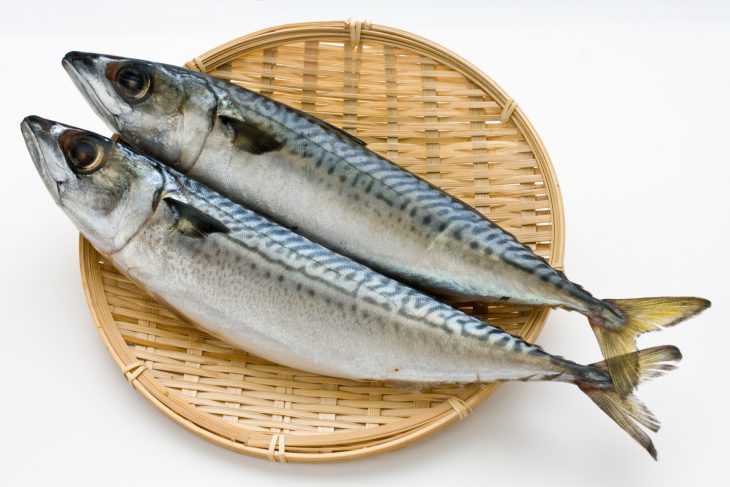
The Fukuoka area is home to both the lucky round-shaped chub mackerel as well as the southern blue mackerel which is characterized by the black spots found on its belly. Both varieties can be caught by methods such as seine and line fishing. The Japanese word for mackerel is written with a Chinese character made up of two components: “fish” and “blue”. This is very fitting seeing as the mackerel is perhaps Japan’s best-known blueback fish. It is rich in vitamin E as well as other nutrients known to help maintain and promote good health. In Fukuoka fresh mackerel is often eaten raw as sashimi, but it is also often prepared in a variety of other ways such as shime saba (marinated mackerel), salted and grilled, and simmered in miso sauce.
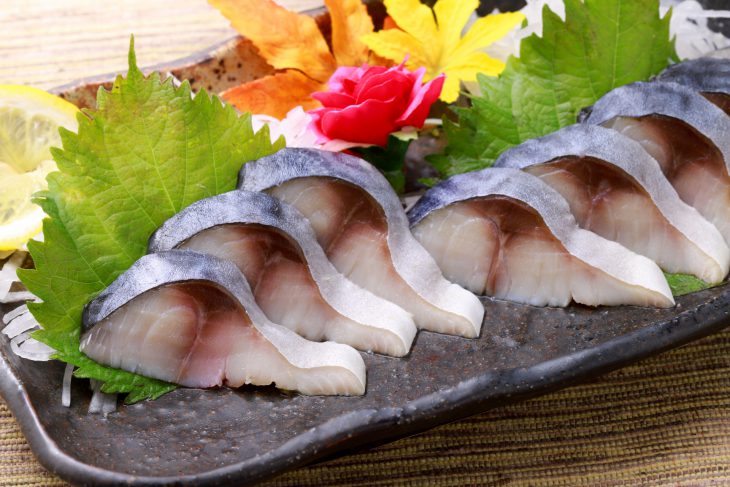
「Saltwater Eel」

The saltwater eel (anago) is very similar in appearance to the freshwater eel known in Japanese as unagi. The Japanese word anago (lit. “hole child”) is derived from the fact this species of eel will dig a hole in the sandy depths of the inland waters and lie in wait until nighttime when it comes out to catch its prey. Fishermen take advantage of this natural trait and will put bamboo cylinders or baskets filled with bait into the water at nightfall and wait for the anago to come and take the bait overnight, removing these traps as well as the anago caught in them the following morning. With just the right amount of fat, this white meat eel tastes great in dishes such as kabayaki (eel dipped and broiled in soy-based sauce), as a sushi topping, and in anago meshi (rice mixed with eel), and other dishes.
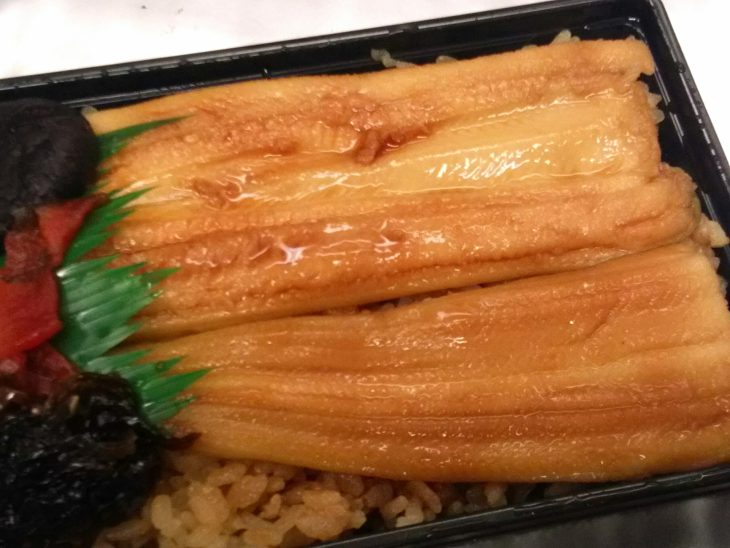
「Horse Mackerel」

In the coastal waters of Japan you will find a variety of species of horse mackerel such as Japanese jack mackerel (maaji), the round-bodied maru-aji (round horse mackerel), torpedo scad (oni-aji), the flat whitefin trevally (hira-aji/kaiwari), and the striped jack mackerel (shima-aji). However, it is the Japanese jack mackerel (maaji) which is the most common variety and has come to be considered a delicacy in recent years. Known and loved by the Japanese for generations, Japanese horse mackerel is a light, flakey fish with a unique fatty, savory taste often enjoyed raw as sashimi, lightly seared as tataki, salted and grilled, or split in half and enjoyed as himono (dried fish).
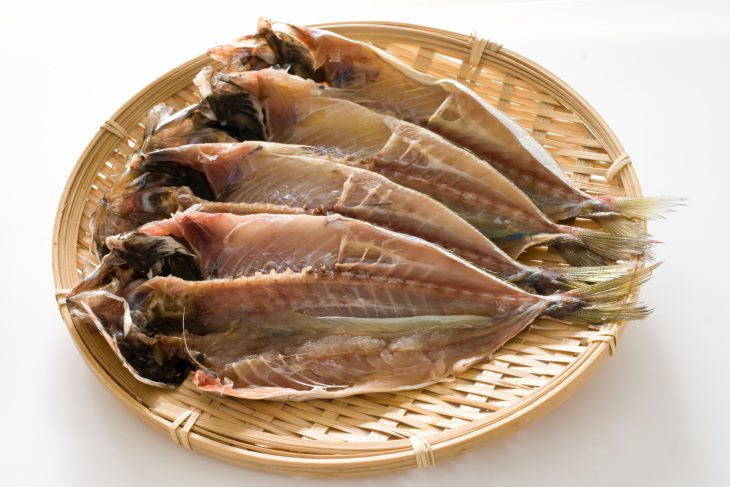
「Japanese Whiting」
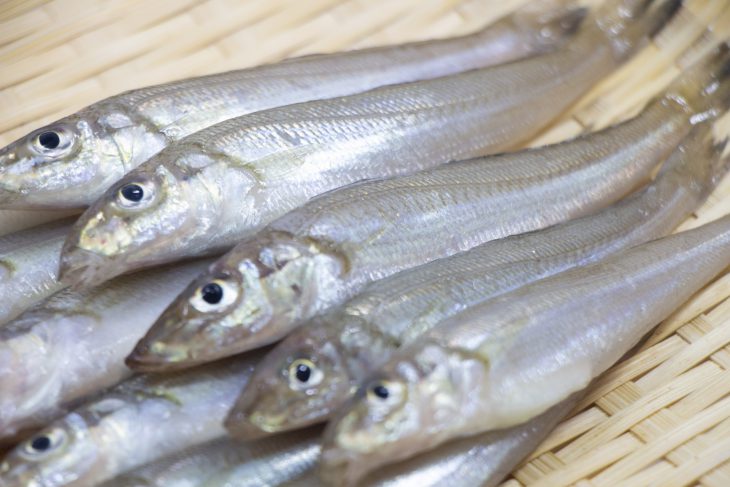
Net fishing season begins in May, after which the country begins to see plenty of fresh Japanese whiting (kisu) line the fish markets and store shelves. The Japanese whiting lives in the clean sandy ocean floor and is a popular catch among casting and boat fishing enthusiasts. This white meat fish has a mild, refined flavor which tastes great in simple dishes such as tempura, marinades, and salted and grilled. Japanese whiting is especially popular in tempura and has been cherished by the Japanese for generations.
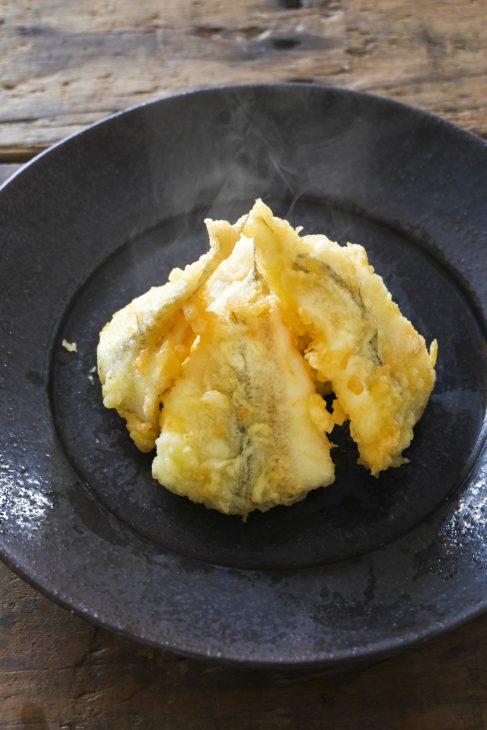
Chicken Grunt・Red Sea Bream・Kuruma Prawns・Octopus
「Chicken Grunt」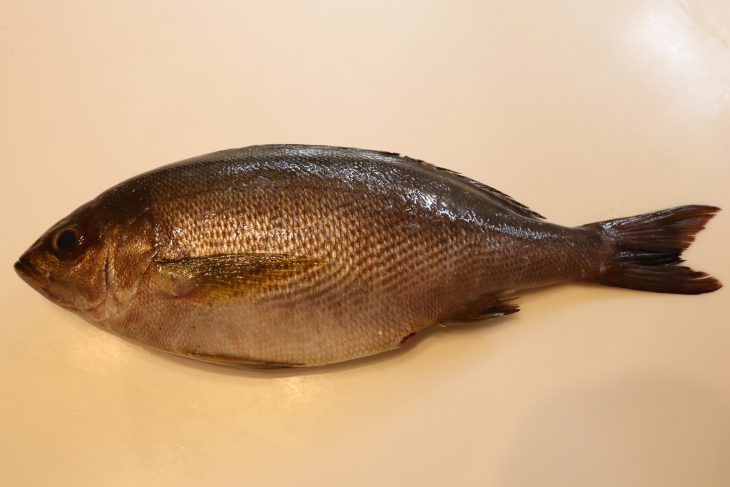
The chicken grunt (isaki) rides the ocean current to make its way north from its southern habitat to the Chikuzen Sea around early summer (isaki season) where it lays its eggs. Because this fish is found in large schools, isaki are almost always sure to be found in habitats such as artificial reefs. This variety of fish is also popular among fishermen. Large isaki in particular are characterized by their unique flavor and beautiful glistening oily white meat which offers an exquisite taste profile when enjoyed as raw sashimi, salted and grilled, or sautéed.
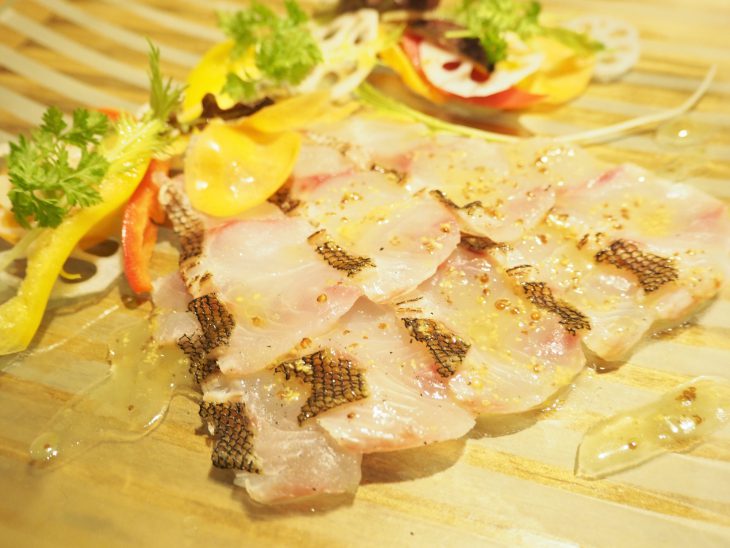
「マダイ」
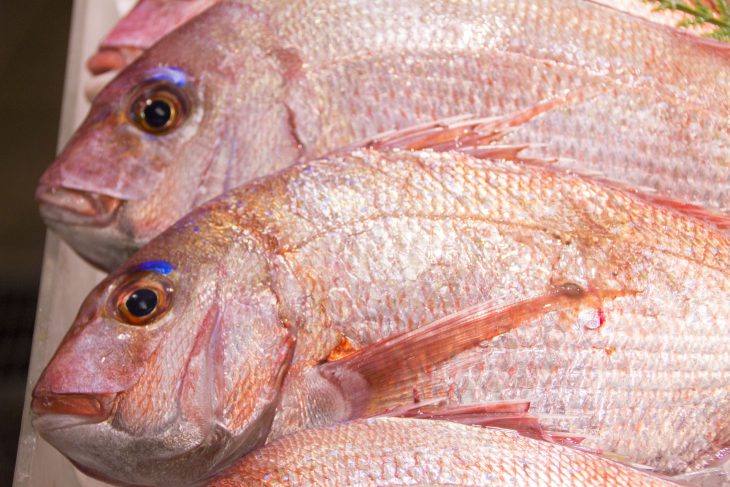
The Fukuoka area sea is known to offer some of the most abundant and highest quality red sea bream in all of Japan. Long loved by the people of Japan, the red sea bream was once a common offering given to a shogun or daimyo and even today large red sea bream is still often enjoyed on special occasions. Red sea bream tastes great as raw sashimi, salted and grilled, in suimono (clear broth soups), simmered in sauce, in taimeshi (sea bream mixed with rice), and even in shabu-shabu dishes. This delicious variety of fish is found not only in Japanese cuisine, but also goes great in Western-style dishes such as acqua pazza, carpaccio, and poele dishes.
「Kuruma Prawns」
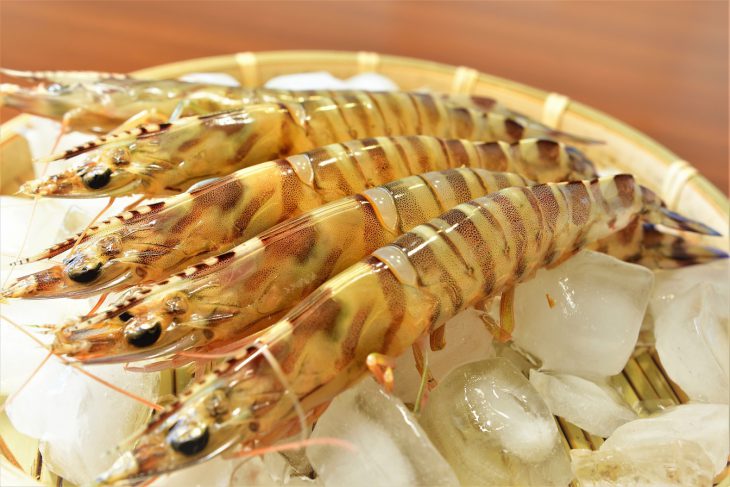
Fukuoka’s nearby Chikuzen Sea is known throughout Japan as the number one region for wild kuruma prawns in the whole country. Thanks to its exquisite flavor, the kuruma prawn is both a popular yet expensive high-grade variety of prawn alongside the likes of species such as the Japanese spiny lobster.
Unfortunately, changes in the species’ natural habitat due in part to human activities have caused the number of wild kuruma prawns to decrease over recent years, thus causing farmed kuruma prawns to become the norm. However, thanks to local efforts such as releasing kuruma prawns back into the sea, the availability of wild kuruma prawns is now once again on the rise. This species of prawn is an important part of gourmet dishes including sashimi, salted and grilled prawns, and tempura dishes.
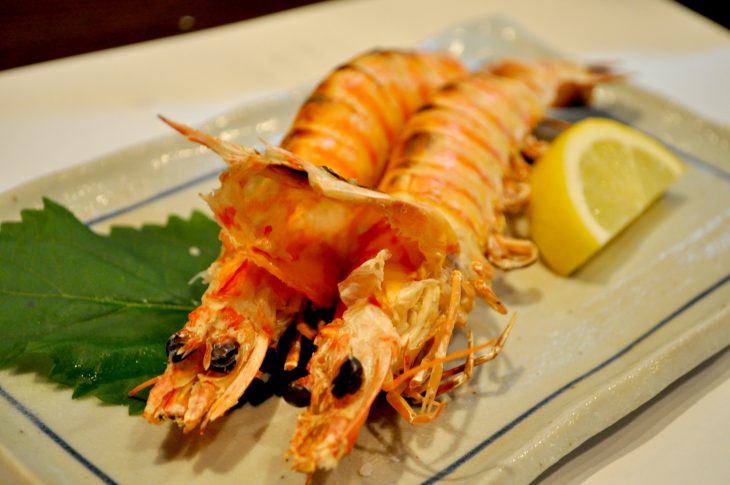
「Octopus」

When the Japanese use the word tako, meaning octopus, they are usually referring to the species known as madako, the most commonly used species of octopus in Japanese cooking. Japanese octopus has become increasingly scarce over recent years, and the octopus you will typically find at Japanese supermarkets is not raw but rather boiled.
Octopus is used in a variety of Japanese dishes such as boiled octopus sashimi, tako meshi (rice mixed with octopus), pickled dishes, and sushi, as well as in Western-style dishes such as marinated octopus.

Thread-Sail Filefish・Japanese Rockfish・Wakame Seaweed・Large-Scaled Grinner
「Thread-Sail Filefish (Kawahagi)」
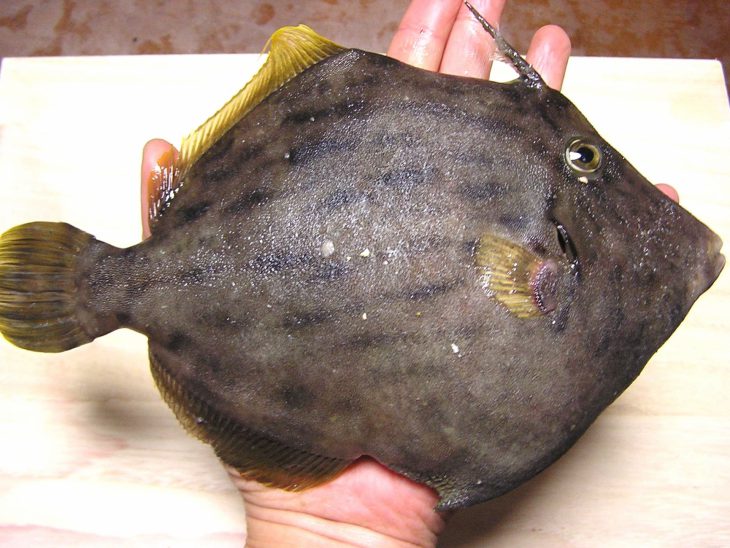
Fukuoka’s Chikuzen Sea is also home to a species known as the thread-sail filefish (kawahagi in Japanese) as well as the long-faced black scraper (known as umazurahagi, or menbo in the local dialect). The Japanese name kawahagi is derived from the words kawa (skin) and hagu (to peel) as you first peel off the skin of this fish before cooking. Fishing umazurahagi has grown in popularity in recent years and this fish is commonly used in making himono (dried fish).
Kawahagi tastes great in dishes such as sashimi, simmered dishes, and Japanese hot pot, and the liver is likewise prized for its deep, rich flavor.

「Japanese Rockfish (Mebaru)」
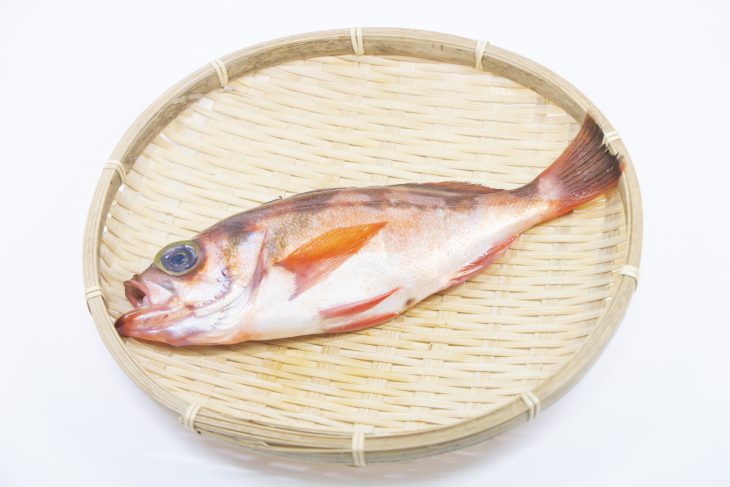
This common variety of fish is found in the coastal waters throughout Japan. The Japanese word for the Japanese rockfish is mebaru, which literally means “popped out eyes”, a fitting name as its eyes almost appear to pop out of its head. Although there are over 100 different species of Japanese rockfish, there are three varieties of mebaru you will typically find in modern Japanese markets: red (akamebaru), black (kuromebaru) and white (shiromebaru).
Loved for its soft, chewy texture, this type of fish tastes even better when in season thanks to its almost sweet flavor. This versatile fish can be enjoyed in any number of ways: as raw sashimi, simmered, salted and grilled, and more!

「Wakame Seaweed」
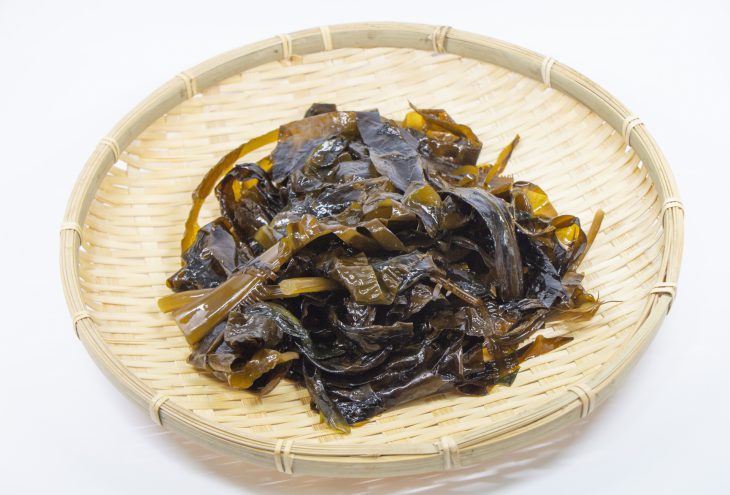
Loved by the Japanese for generations, wakame is a kind of edible seaweed found in a variety of traditional Japanese foods. Wakame is a versatile food packed with nutrients and which offers a range of flavors and uses depending on the part of the plant that is used: the wakame leaves themselves are used in dishes such as miso soup and salads, whereas the core part of the plant known as kukiwakame has a crunchy texture and has become a popular snack food in recent years, and the flowering part of wakame, known as mekabu, has a slimy texture and is often used in aemono salads and as a topping for noodle dishes.
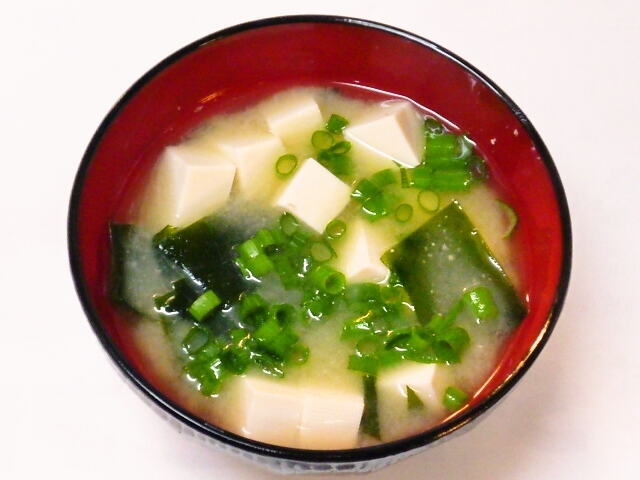
「Large-Scaled Grinner (Maeso)」
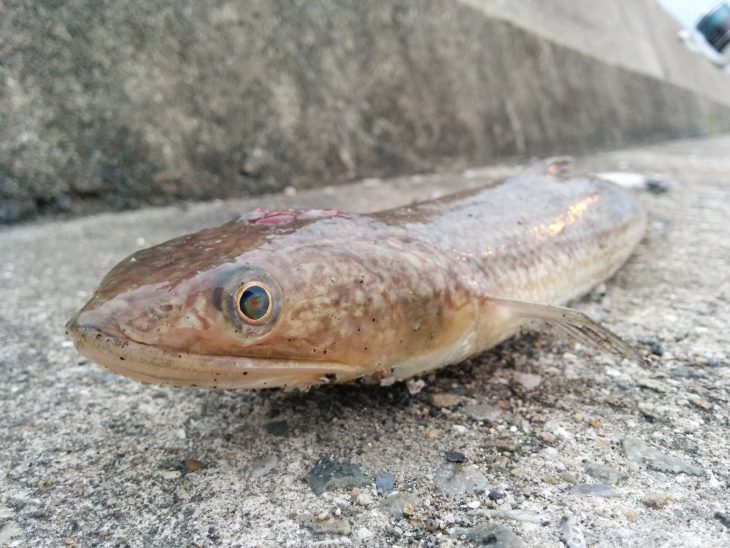
This long, thin fish measures some 50 centimeters in length and is somewhat reptile-like in appearance, the surface of its body covered in large, slimy scales. It is characterized by its big eyes, sharp teeth, and large mouth which stretches all the way out beneath its eyes as if it had been ripped apart, all the better to swallow up all the little sardines and other tiny fishes it preys on.
A white meat fish often known for its use in foods such as high-grade kamaboko, maeso is a fish you won’t often find available fresh, but it is also very tasty when grilled, in surimi (fish paste meat) or as ichiyaboshi (salted and dried).
 (Taken from the Houki Kamaboko website)
(Taken from the Houki Kamaboko website)
Spear Squid・Young Yellowtail・Righteye Flounder・Olive Flounder
「Spear Squid」
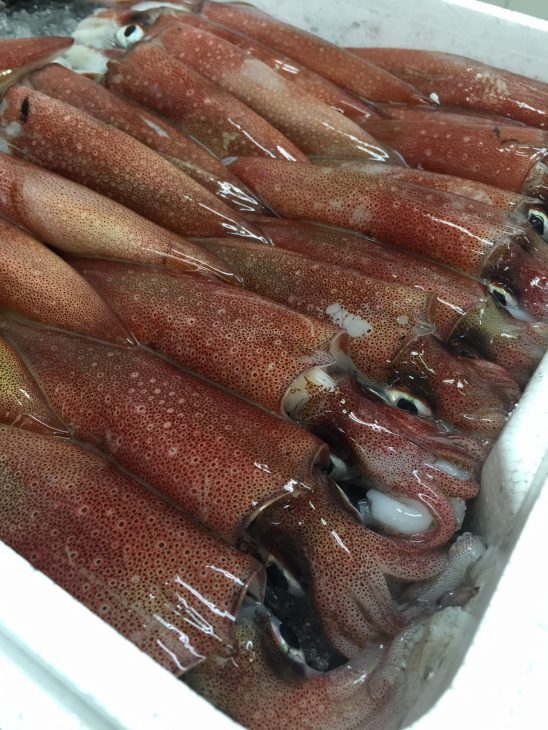
The spear squid derives its name from its pointy spear-shaped fins. A popular target for offshore fishing during the winter season, the spear squid also makes a very tasty, popular meal as well.
Spear squid meat has both a soft and crunchy texture, which makes for some of the finest sashimi there is. In fact, there are a number of restaurants in Fukuoka where you can eat this variety of squid alive, a unique dish known as ikizukuri. After enjoying your ikizukuri sashimi, you can also have whatever is leftover made into tempura so you can enjoy a variety of different flavors.
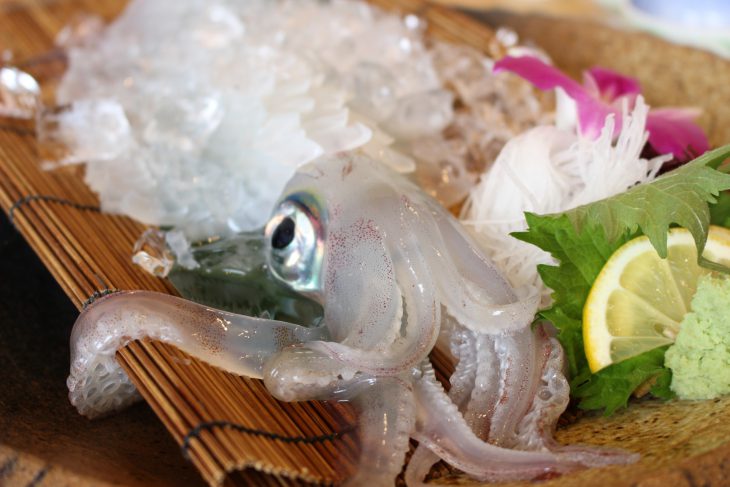
Young Yellowtail (Yazu)
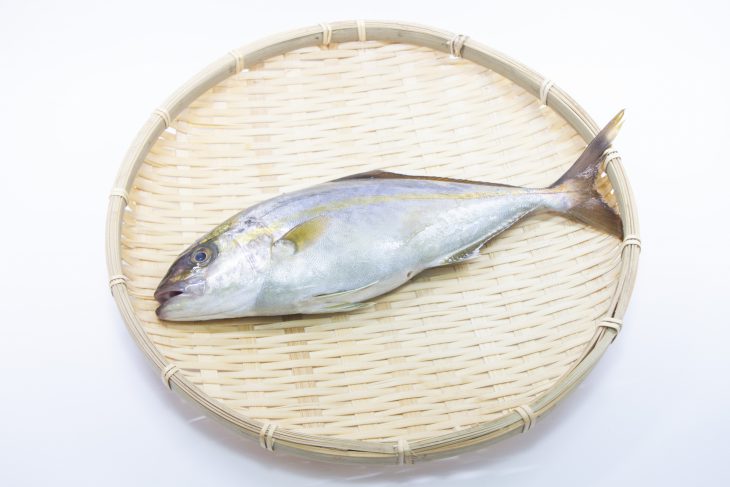
This blue-backed fish is both plentiful and very commonly used in Japanese cooking. Young yellowtail (yazu), which are actually known by different names in different parts of Japan, have a fresh, lighter flavor compared to the more fatty older yellowtail and are known for their chewy texture.
Young yellowtail tastes delicious whether eaten raw as sashimi or in other dishes such as teriyaki or deep-fried dishes.

「Righteye Flounder (Karei)」
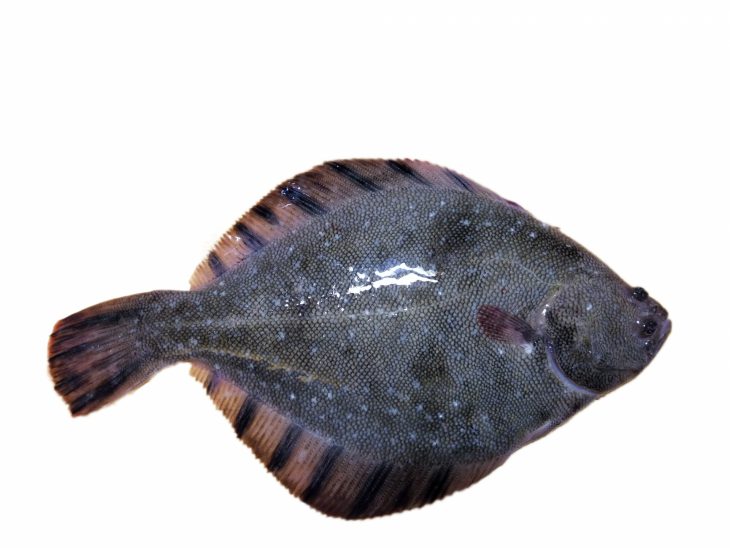
There is a Japanese saying that goes “Left is hirame and right is karei” which refers to the fact that the fish known in Japanese as karei (righteye flounder) will be found with both its eyes on its right side, whereas hirame (olive flounder) will be found with its eyes on the left. In and around Fukuoka you can catch a great variety of righteye flounder species such as mako garei (marbled sole), and Japan’s coastal waters alone are home to over 40 species of karei.
Often used in typical Japanese dishes such as karei no nitsuke (flounder in simmer sauce), righteye flounder is equally tasty as sashimi, deep-fried, or a la Meuniere.
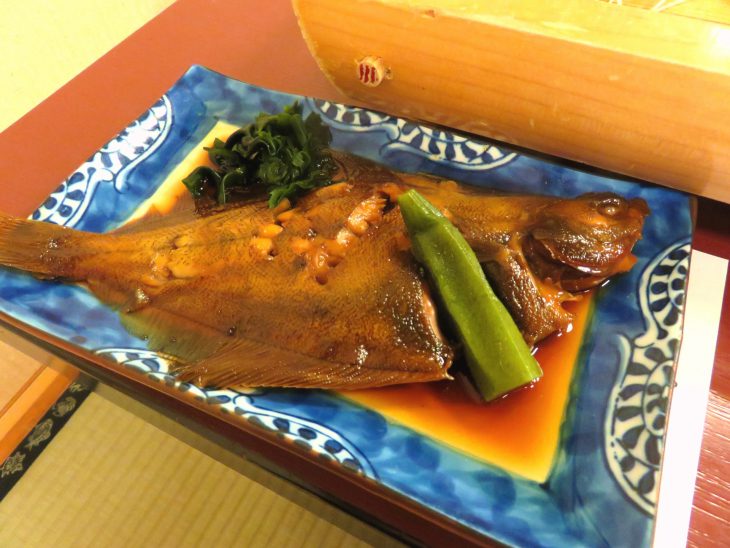
Olive Flounder (Hirame)
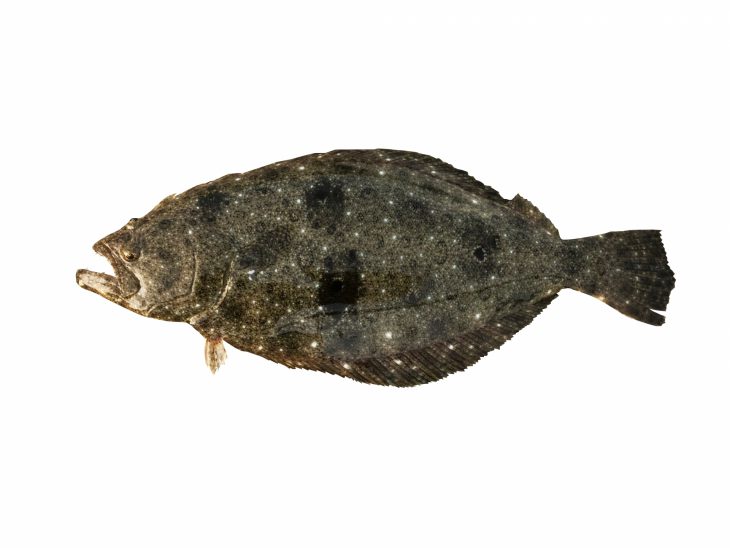
In contrast to the right-eyed karei, olive flounder (known as hirame in Japanese) will be found with its eyes on the left side of its body. Found near the sandy seabed of the coastal waters and active largely at night, olive flounder feed largely on the small fishes found in the waters of the Fukuoka area. Known for being a high-grade variety of fish, this fast-growing species of flounder is actively farmed to meet its high demand.
It is often said that righteye flounder is for simmered dishes and olive flounder is for sashimi. This is thanks to olive flounder’s delicious mild flavor that goes great with both soy sauce and ponzu sauce.
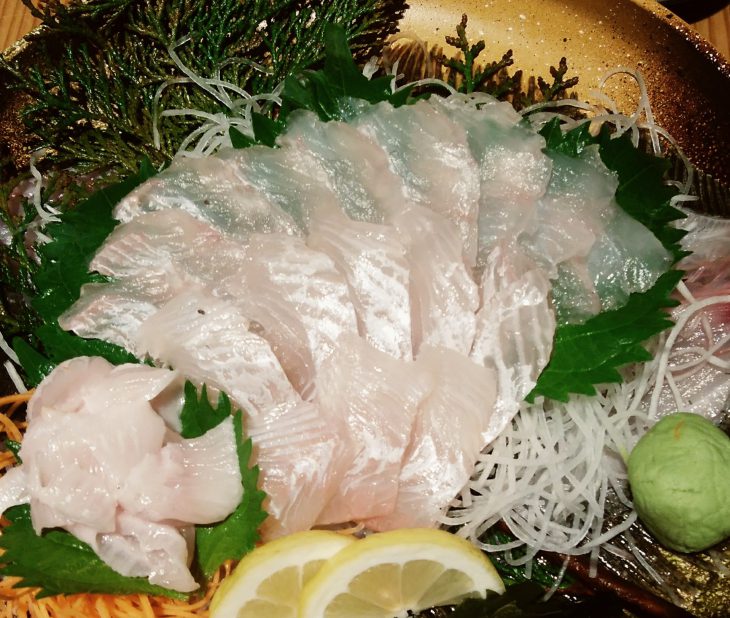
Seafood simply tastes far, far better when in season. And it is perfectly safe here in Japan to enjoy the delicious taste of raw fish and shellfish sashimi. Fish is an essential part of Japanese cuisine, so be sure to try out some of June’s fresh seasonal seafood here in Fukuoka, the city with the most delicious seafood restaurants in all of Japan!
